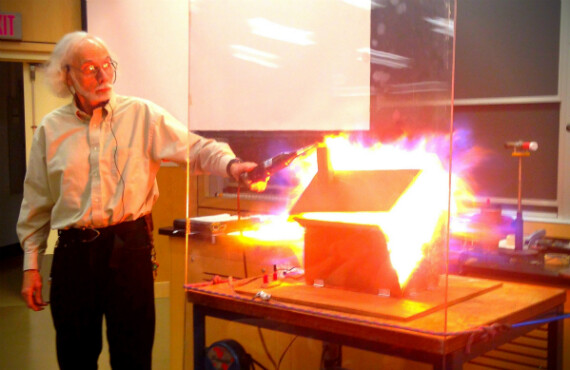Modern-Day Ben Franklin Conducts Electrifying Science Demonstrations at Penn
As the founder of the University of Pennsylvania, Benjamin Franklin’s legacy and spirit of innovation continues each day in the College of Arts and Sciences. In fact, there’s a modern-day “Ben Franklin” at Penn.
A lab demonstration coordinator in the Physics and Astronomy Department, Bill Berner embodies the idea of local engagement and educational enrichment.
Normally, he works behind the scenes to design, set up and maintain the equipment that faculty members use for their physics class demonstrations. But, for two days each winter, Berner shines in the spotlight in the main lecture hall at the David Rittenhouse Laboratories where he conducts live “science shows” for area grade school and high school students.
“It’s the one time all year, when I take the place of the faculty member in front of the class, trying to use this equipment to get physics to make sense,” Berner says.
It’s not surprising why these demonstrations spark the interest of young people.
With an air of fun, Berner presents alternate themes each year, like understanding static electricity, currents, magnetism, electromagnetic waves, and lasers. He even channels electricity through lightning rods, a nod to Ivy League Penn’s founder and the humble beginnings of scientific experimentation.
But, Franklin’s widespread, electrifying influence on Berner’s life doesn’t stop there. It all started when Berner visited the Franklin Institute in Philadelphia as a kid. While he didn’t exactly grasp the concepts at the time, the live demonstrations stuck with him and eventually led to a 25-year career teaching high school physics.
In 1996 when he arrived at Penn, he thought, “I wish I had this kind of stuff to teach high school students with,” and that’s how the program began.
He believed local schools were doing a good job, but they were fiscally limited with the kinds of things that they could do to illustrate scientific concepts.
“My goal was to give area students a memorable, positive experience with physics that would show them that the classroom isn't the only place they can learn science,” he says. “It is a whole lot of work to put it together every year, but the size and response of the audiences never fail to pay back more than I put into it.”
Since its inception 17 years ago, the program has evolved into two days of shows.
Largely organized by Berner, with the support of department chair Larry Gladney and the School of Arts and Sciences’ Science Outreach Initiative, the demonstrations are free and open to the public.
This year, they had more than 500 students from local schools including Southwark, Downingtown West, Little Flower, Friends Select, Sterling, Upper Dublin and Lower Merion, along with a few dozen home-schooled children.
“Physics teachers generate more ‘ah ha! Moments’ than teachers in any other subjects,” Berner says. “With all the resources we have at Penn, I get to produce even more than usual.”
Much as the Franklin Institute shows did for him, Berner’s demonstrations energize young people’s interest in science and may influence some of them to pursue careers in science, technology, engineering and math-related, or STEM, fields.
Berner says he’s filling a gap, letting students see and experience phenomena that are only described in textbooks. To make it more than just a magic show, his demonstrations are presented in a logical sequence to help the children to develop complete scientific concepts. He says the shows’ most popular parts vary by topic.
“For electricity, it is unquestionably the lightning rod and the house that blows up. For the waves and light show, it seems to be a toss-up between breaking a wine glass with sound and filling the auditorium with smoke to trace laser paths,” Berner explains. “And, for mechanics, it is the oscillating spring-mass system that uses me as the oscillating mass, hung from the ceiling by a six-foot-long garage door spring.
“The best way for teachers to find out the dates would be to write us directly or to watch our Website for an announcement,” says Jane Horwitz, the director of the SAS Science Outreach Initiative. “This program upholds the Penn Compact through high-quality STEM educational opportunities that meet the community’s needs.”
This year’s shows were videotaped and are available online so that they are accessible to students, teachers or anyone with a budding interest in science.
The Ben Franklins of tomorrow may just get a positive charge out of them.








